|


Click below to skip to individual topics:
Running Awardly ... Pulling and Pushing Things ... Throwing Things ... Walking Upstairs
Listening to Music ... Dancing to Music ... Finding Things ... And Bringing Them to You
Make a Tower of 3 - 4 Blocks ... Knock it Over ... "Turn the Page" ... Little Things & Containers
This is Too Hard for Me! ... This is Too Easy! ... Sitting in a Chair That Fits
Feeding Oneself ... Stubbornness ... Tantrums ... Pointing and Naming
Body Parts & Self-Awareness ... Changing Table Games
Humming, Singing, and Scatting ... Learning to Use Speech ... A Vocabulary of 10 to 12 Words
The Commander General ... Baby Talk ... My Favorite New Word ... Security Blankets
Discipline ... Learning Right & Wrong ... Toddlers & Teddy Bears ... Teddy Bear Activities
A one-and-a-half-year-old child gives you the opportunity to go back to your childhood and play. If anyone asks you what you are doing when you're on the floor acting like a growling tiger, just say that you're preparing your child for college. For the fact is, children do learn through play. Play is the activity that they invent to study the world around them.
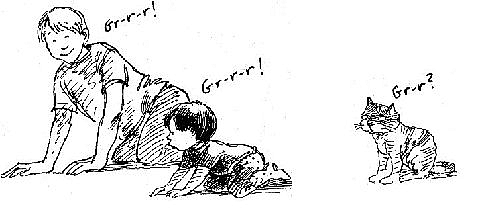
Some learning psychologists have estimated that by the age of five, a child's intelligence quotient (lQ) is basically established. They say that by this age attitudes toward learning and patterns of thinking have settled into children's minds, and that these same attitudes and patterns guide their thoughts for the rest of their lives. Fortunately, the way children learn is fun - fun for them and potentially fun for you. By understanding that through play children learn to concentrate, exercise their imagination, try out ideas, and practice various behaviors, you may come to respect the process enough to get involved with it.
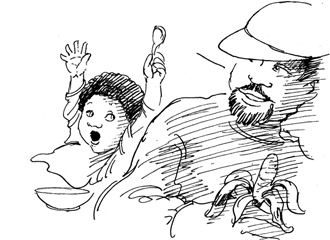 Your involvement and interest in your child's play will make a big difference in your child's life. In homes where discovery is discouraged, children often learn how not to play, a tragic outcome, to say the least. In homes where early explorations are encouraged, the minds and personalities of children grow and develop the potential that is each child's natural legacy. Your involvement and interest in your child's play will make a big difference in your child's life. In homes where discovery is discouraged, children often learn how not to play, a tragic outcome, to say the least. In homes where early explorations are encouraged, the minds and personalities of children grow and develop the potential that is each child's natural legacy.
Your child's spirit is a mixture of curiosity and pleasure. But, once you let it start to grow on you to the point where you truly enjoy playing with your child, you may feel betrayed. You offer a favorite food or activity and your child shouts, "No!" Suddenly, your child is no fun at all. Why? What's going on? This chapter and later chapters as well will explain what your toddler is going through and tell you ways to cope.
Running Awkwardly
 Children this age like to run, but they run awkwardly. They don't yet bend their knees much when they run. They need practice, so make sure in the coming months to provide spaces where your child can run freely and safely. Watch them carefully because, despite their ineptness, they are brave and adventurous - and surprisingly fast. So watch out! Toddlers can start to run across the street while your head is turned to chat with a friend. Children this age like to run, but they run awkwardly. They don't yet bend their knees much when they run. They need practice, so make sure in the coming months to provide spaces where your child can run freely and safely. Watch them carefully because, despite their ineptness, they are brave and adventurous - and surprisingly fast. So watch out! Toddlers can start to run across the street while your head is turned to chat with a friend.
Children learning to run inevitably fall down. Since they don't have far to go, they usually don't get hurt seriously. Bloody lips generally heal quickly. React calmly, but don't be afraid to consult a doctor if you think it's necessary.
Pulling and Pushing Things
Children this age also like to demonstrate their ability to walk well and to make something else move, too. That's why they like wheel toys they can pull along after them and toys they can push ahead of them.
Pull toys and push toys come in various shapes and sizes. Some make noises, which makes the event even more satisfying because your child is causing the noise to happen. Some toys can be both pushed and pulled.
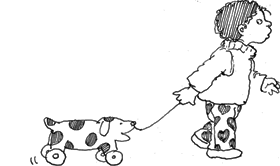 Pull and push toys make great presents for kids this age. Pull and push toys make great presents for kids this age.
Some of the most fun pull toys are:
• Small wagons that are not too heavy for a young child to pull
• Dogs that bark
• Other animals, such as giant caterpillars
Some of the most fun push toys are:
• See-through toys with balls inside that make sounds when they pop around
• Toy vacuum cleaners
• Toy lawn mowers
The last two can be used by your child to "help" you work.
Throwing Things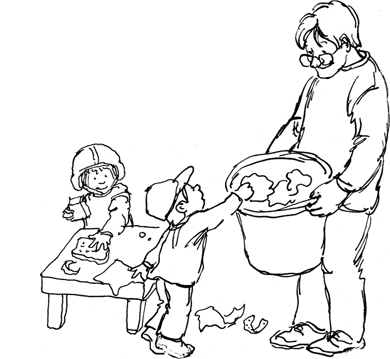
Toddlers like to hurl things. Again, this skill demonstrates to the world that they can move things and make things happen. Toddlers are not passive; they want to affect the world around them. Throwing things is one way to do that. Unfortunately, toddlers don't have very good aim, and objects they hurl are apt to go in any direction. So toddlers need to be helped to know what to throw and what not to throw - and where to throw the things they can throw.
You can help them practice throwing by giving toddlers safe things to throw. Beanbags are great, and sometimes you can get older siblings to make them as presents for toddlers. But if you don't have beanbags, make balls of tightly crumpled junk mail; your child may like to make paper balls, too. Without too much trouble, your throwing activity can turn into a clean-up game, especially after parties.
Walking Upstairs
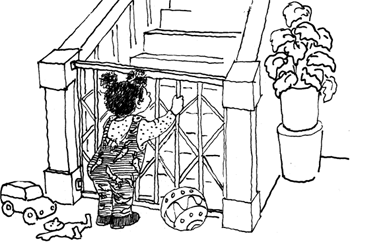
Stairs present a fascinating challenge to children. They see older people climbing up and down them, and they want to try, too. They start by crawling up and down, gradually progressing to walking up and down. At first they put both feet on a tread, take one step, and move the other foot up so that they have both feet on the next tread. They start this process when they are ready, and they need you to hold their hand. By 21 months they have usually mastered the two-feet-to-a-tread method.
Gates: Gates are necessary at both the top and the bottom of stairs. Install them well, and make sure your child can't open them. Gates are very important in preventing staircase accidents.
Listening to Music
Toddlers benefit from hearing music, experiencing rhythms, and, most of all, from sharing the numerous sensory pleasures of music with you. To have a musical child, you don't have to be professional musicians nor is it necessary to send your toddler off to piano lessons. If you want your child to enjoy music, start by enjoying it together as a family at home. Sing your favorite songs to your child, listen together to children's tapes and CDs, and have family jam sessions with maracas, drums, and tambourines.
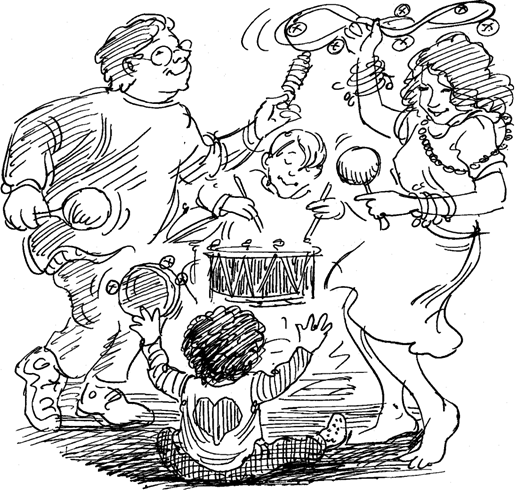
Dancing to Music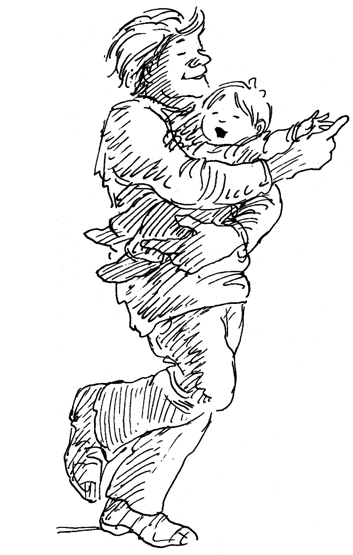
Toddlers like to dance in different ways. Sometimes they like to stand in place and jiggle. Other times they like to walk around to music. They also like to dance with you, either holding your hands or being waltzed around the room in your arms. Dancing is good for kids. It helps them learn about music, develop coordination, feel creative, and have fun.
Different dance activities
Mirror dancing:
Dance and sing together in front of a full-length mirror. Your toddler likes to see the two of you having a good time.
Musical toy game:
Save a musical crib toy for dancing to. Let your child hold it and make it go. When the music plays, you both dance. When the music stops, you both stop dancing.
Exercise dance:
Make up a series of simple exercises that are good for you and simple enough for your child to more or less do with you. The simpler the dance, the better. A five-minute routine is about all most toddlers can handle. If you want, wear weights to increase your challenge. If your child wants to wear "weights," too, put stretchy (but not tight) ponytail ties around his or her arms and legs.
Finding Things ...
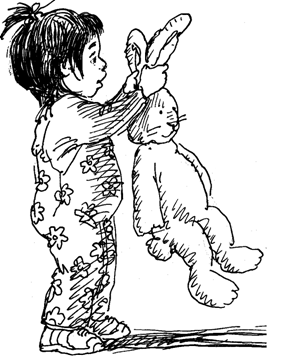 Here's a simple activity that helps your child practice a number of important skills. The activity consists of your asking your child to fetch a particular item, waiting for your child to find it, and rewarding your child with an enthusiastic hug when the item is brought to you. The fetching game can be played anywhere, and it doesn't require any particular equipment. Here's a simple activity that helps your child practice a number of important skills. The activity consists of your asking your child to fetch a particular item, waiting for your child to find it, and rewarding your child with an enthusiastic hug when the item is brought to you. The fetching game can be played anywhere, and it doesn't require any particular equipment.
Because this activity is so basic, its multiple benefits can be overlooked, yet they bear discussion. Some of the skills this activity teaches are:
Language skills
To find something you ask for requires that your child first of all understand its name. Your child may not be able to say the name but understands the meaning of the word when you say it. Your child is learning to react to a request and to understand directions.
Social skills
Your child is learning to cooperate by bringing you something you ask for.
Gross motor and fine motor skills
Gross motor skills involve large muscles such as arm and leg muscles. Fine motor skills involve small muscles, such as hand muscles. Finding things and bringing them to you can involve both.
Task persistence
To start a job and finish it is one of the most useful skills a person can learn. The task you ask for should be simple enough for your child to do.
... And Bringing Them to You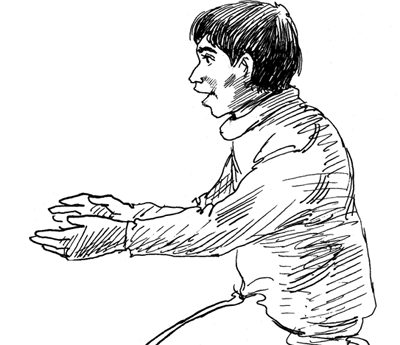
Listen to all the language that your child hears when you play this game. Such language enriches your child's life and is one of the greatest gifts you give your child.
Listen ...
Where's Rabbit? Is she hiding? Can you find her? Will you bring her to me, please? Is she under your crib? No? Is she peeking out from behind the chair? No? Is she under the pillow on the couch? Yes? Is that her ear you see? You found Rabbit! That's my girl. Now, will you please bring Rabbit to me? Thank you. What a good job! You want me to hide Rabbit again?
Hint: Only hide things that your child will be able to find. For younger children, put the object across the room in a place that's easy for your child to spot. Your child will be excited to "find" it there.
Make a Tower of 3 to 4 Blocks
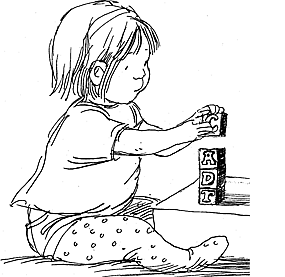 The main guideline to keep in mind when helping your child plays with blocks is that toddlers need blocks they can lift by themselves. The main guideline to keep in mind when helping your child plays with blocks is that toddlers need blocks they can lift by themselves.
One-and-a-half-year-olds are not yet ready for heavy wooden blocks. They like the small lightweight plastic or wooden blocks. They also like bigger hollow cardboard blocks, especially if you lend your assistance in making a tower. Don't get too elaborate with your plans.
Children this age usually make towers that are only three or four blocks tall. For them, this is a major accomplishment. For you, it's a time to appreciate just how much eye-hand coordination your child has acquired in a year and a half.
Knock it Over
The fun of making a tower isn't fully realized until it is knocked over. Young children delight in being able to feel powerful. After they knock the tower over, they want to build it again. Building and knocking over towers is a good activity that you can enjoy as long as you don't have to keep on picking up the blocks. If your child wants to build and destroy block towers, set him or her on the floor. If you feel like it, count blocks as they are added to the tower, and make appropriate comments such as "Boom!" as your child topples them.
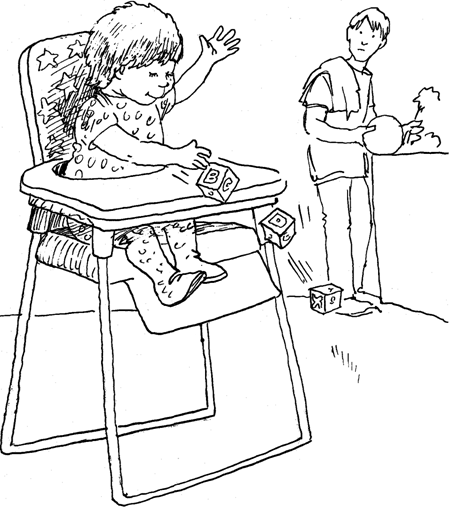
"Turn the Page"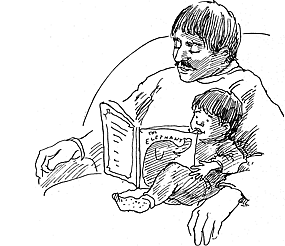
Toddlers like to sit on your lap and have you read to them. Not only do they like to look at the pictures and hear your voice, but they also like other aspects of book reading. For example, they are intrigued by the action of page turning. When your child reaches out to help you turn a page, respond positively.
Let your child turn the page with you, or let the child turn the page alone, if possible. Eventually, when it's time to turn a page, you can just say, "Turn the page," and your proud child may do it for you.
One-and-a-half-year-olds enjoy handling small objects. They like to manipulate these objects in different ways and will think up things to do with the objects by themselves, occasionally taking suggestions from you. Sometimes kids will vary their activities; other times they'll do the same activity over and over again with satisfaction. If your child seems bored, introduce a new container to explore. Get your child to pick up the small things with you as a game when finished with them. The last container used can be the storage container.
Little Things & Containers
Little things kids like:
- Stones and pebbles
- Acorns and nuts
- Small cars
- Small people and animal figures
Interesting containers:
- Boxes of all sizes
- Clean plastic bottles that little things can be dropped into
- Empty pill bottles - cap them and shake little things inside
- Mailing tube - what happens when you drop things inside?
Safety precautions:
Don't give young children toys that are so small they could be swallowed, unless you are playing with your child and are watching to make sure your child does not suck on them.
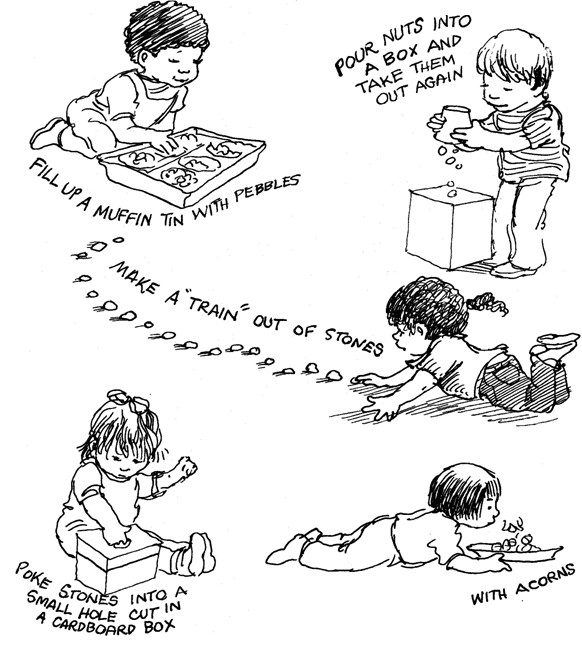
This is Too Hard for Me!
What does "developmentally appropriate" mean?
"Developmentally appropriate" is a term used by educators to refer to materials and activities that suit your child's abilities - not your child's age, because children of the same age may have different abiitites. Developmentally appropriate materals are neither too hard nor too easy for your childn, but appropriately challenging, and therefore quite satisfying, both to your child and to you as well, because you don't have to do the activity for your child.
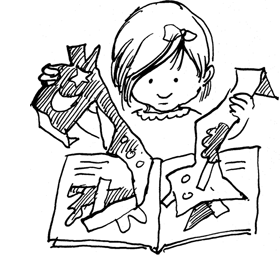
This is Too Easy!
How can I tell what is developmentally appropriate for my child?
Observe your child at play. Which toys does your child really like to play with? Which activities and games capture your child's attention? These are the toys and activities that are developmentally appropriate for your child. The toys and games described in this book can steer you in the right direction, but the best guide is your child, who wants to be neither bored nor frustrated.
Sitting in a Chair That Fits
If you want your child to eat calmly or work quietly at activities such as coloring and putting puzzles together, you would do well to think about where you are asking your child to sit. Chairs that are too high or too low for the table are uncomfortable for children, and they may be unsafe, too. Children sit longer when they are comfortable.
The two most comfortable chairs for children are high chairs and toddler-size chairs that fit toddler-size desks. You can buy inexpensive plastic child-size furniture; it is a good investment because a comfortable child is a contented child. Also, low chairs and desks are safer than high chairs.
Feeding Oneself
Learning to use a spoon and a cup
Children this age want to learn to use a spoon. Serve them foods, such as mashed potatoes and mashed beans, that will stay on the spoon. Don't expect your child to get all the food into his or her mouth. Be prepared to clean up messes calmly as learning proceeds. To help your child learn to use a cup, provide a training cup with handles, a weighted bottom to prevent tipping, and possibly a cap with a built-in straw.
Favorite finger foods
Toddlers like to eat food they can pick up with their fingers. Make sure their hands are clean first, then serve them a plate of tidbits, such as: cheese cubes, vegetable cubes, fruit slices, berries, tofu cubes, sliced hot dogs (nutritious type), cubes of meat, strips of French toast, and bite-size pieces of omelet.
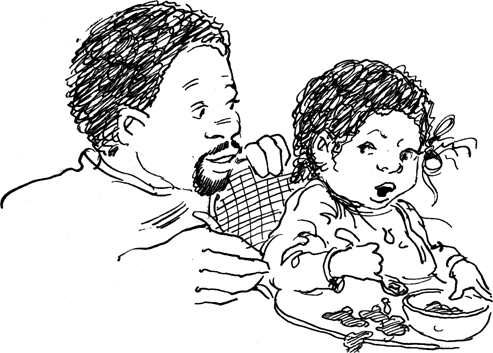
Stubborness
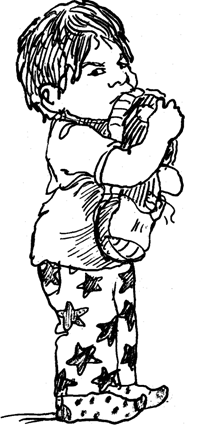 One-and-a-half-year-olds begin to exhibit a sense of possessiveness. They start to perceive things, such as favorite books and toys, as belonging to them. This development is part of a natural and healthy growth in self-awareness. One-and-a-half-year-olds begin to exhibit a sense of possessiveness. They start to perceive things, such as favorite books and toys, as belonging to them. This development is part of a natural and healthy growth in self-awareness.
A child needs to learn that these are my pajamas and those are yours, that this is my shoe and that is yours. This sense of possessiveness will lead eventually to a sense of respect for other people's possessions.
But feelings of possessiveness are complicated. Children want to wear a sibling's socks, despite the sibling's admonitions. They may also want to possess another child's toy.
Be creative.
In these situations, think of something else your child might like to have. Offer it enticingly. Distraction is an effective strategy with toddlers.
Be loose.
Keep your sense of humor, and don't let your child intimidate you.
Be flexible.
Socks? Who cares? Is it really worth a fight? Maybe the sibling will relent.
Tantrums
Toddlers occasionally have temper tantrums. They usually happen when they get a little older, but sometimes they happen at this age, too, and even at younger ages. A temper tantrum is when a child screams and hollers and kicks and flails out and won't respond to any effort on your part to calm him or her down.
Other parents experience them, too. 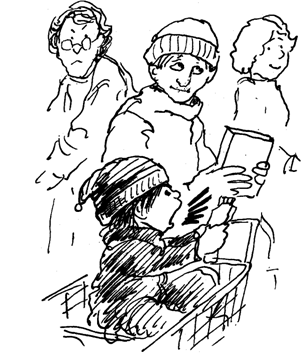
Temper tantrums are embarrassing, but not for your child. Your child doesn't care what anyone thinks. They are embarrassing for you because suddenly it appears that you have raised the most beastly child in the whole wide world. When and if your child has a temper tantrum, accept your embarrassment and then get past it. Anyone watching who has a child is probably sympathizing with you. As for those others who are watching critically and thinking that you are a wretched parent, ignore them.
What to do?
Don't try to argue or reason now. If you have to finish up business in a store, do so as quickly as possible. Make sure your child is safe. Do not hit your child. It's harmful and will only make your child cry more.
If you are dropping your child off at a day-care center or at a baby-sitter's home, take your cues from the caregiver. If she says it's okay to leave, leave. Caregivers are good at handling upset children, and the truth is, most children calm down after their parents leave.
Tell yourself that this, too, shall pass. And it will. Children outgrow temper tantrums once they develop a sense of how the world is looking at them. They really do become more civilized in expressing their feelings.
Pointing and Naming
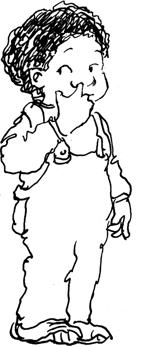 One of the first things that children learn to point to and name are their body parts. Simple games involving this activity are enjoyed immensely by toddlers, and it is great for showing off to visitors, especially gleeful grandparents. One of the first things that children learn to point to and name are their body parts. Simple games involving this activity are enjoyed immensely by toddlers, and it is great for showing off to visitors, especially gleeful grandparents.
Pointing and Naming 101.
The game goes like this: You say, "Where's your nose?" And your child points to it. Stick to basic facial features: eyes, nose, mouth.
Pointing and Naming 102.
You say: "Where's Daddy's nose?" And your child points to your nose. And so on, to Mommy's nose and Grandma's nose.
Pointing and Naming 103.
Add other body parts: ears, hair, cheek. Elbow is a funny one.
Pointing and Naming 104.
Eventually your child says, "Nose," or a word that sounds like "nose." This is graduate-level activity and very impressive. Pointing is one thing, but naming - wow!
Body Parts & Self-Awareness
Some parents think learning is something that happens in the brain only. They think books and educational toys are the key to unlocking the treasures of the brain. While books and toys are thrilling indeed, they are only part of the way a child perceives the world. Learning for children involves the whole body: eyes, ears, mouths, teeth, hands, feet, tummies, arms, and legs.
Children start learning about their bodies at a very young age, and they learn from you. Convey respect and delight for your child's body. Teach your child that bodies need to be well cared for, exercised, and appreciated. Your positive attitude about your child's body will help your child develop a positive sense of self-awareness.
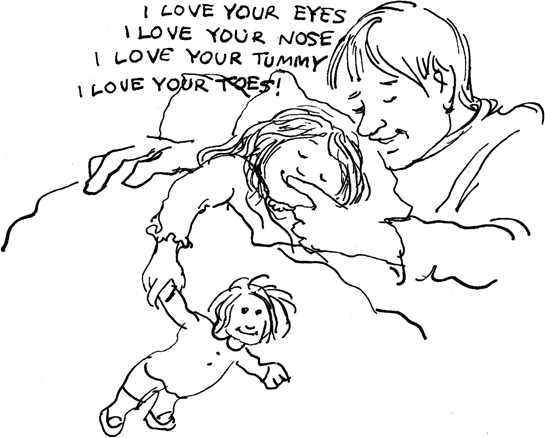
Changing Table Games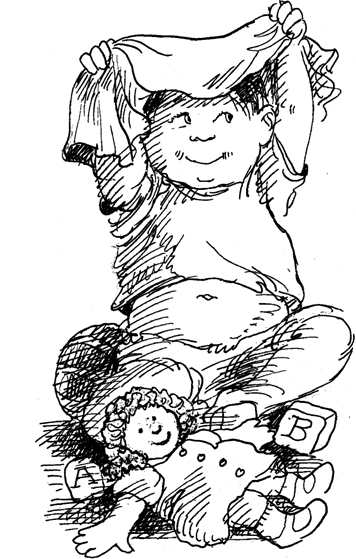
The changing table is a great place to play affectionate games with your child. Keep some toys handy for your child to play with, in case you're not in the mood for games. But if you are, here are some you and your child might enjoy.
• Peek-a-Boo.
It's a babyish game, but kids enjoy it for a long, long time.
• This Little Piggy.
You say the rhyme while you wiggle your baby's toes and then tickle your child under the chin.
• Naming Body Parts.
You ask your child to point to his nose and so on.
• What Does a Cow Say?
In the straight version of this game, your child gives the correct answer, "Moo." In the silly version, he or she gives a deliberately wrong answer, such as "Meow." Hilarious for toddlers!
Humming, Singing, and Scatting
Children this age are beginning to hum and sing. The inception of these interesting skills often escapes parental attention. But when you think about it, babies aren't born knowing how to hum and sing. They learn these skills now, especially if you hum and sing to them. What? You don't have a good voice? Oh, yes, you do. According to your child, you are Pavarotti.
Scatting is useful if you can't remember words to songs. Scatting is singing nonsense syllables. If you like, take the words and sounds your toddler likes and make up a scatting song for them. This is fun to do while you're changing your child's diaper. Baby, Baby, be-bop, ba-dee-bop!
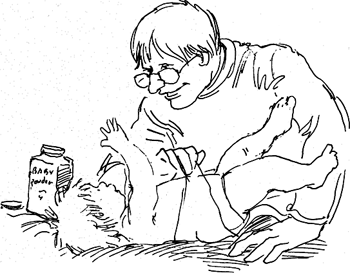
Learning to Use Speech
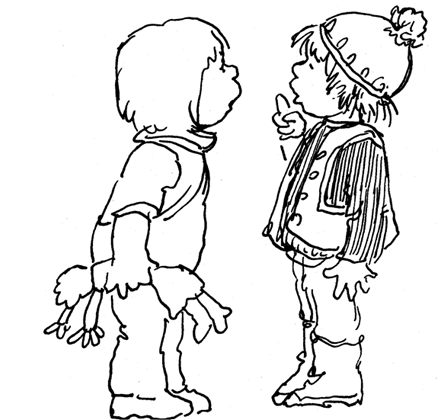
Children want to learn to talk. Sometimes you can see them practicing with each other. Even if the sounds they are making don't sound exactly right, they seem to have all the gestures of adults. They like to say "Sh-h-h" and "No" and "Hi" to each other with all the hand movements that they see you use. They are learning, learning, learning all the time they talk.
A Volcabulary of 10 to 12 Words
A magic moment occurs when your child names a new familiar object for the first time. Being able verbally to make the connection between the spoken word and the actual object is a giant step for your child. The process of langauge acquisition is truly amazing, and watching it happen is one of the great joys of parenthood. What can you do to assist? Talk with your child in natural, joyful ways; and show your respect and appreciation for what your child is accomplishing. Soon you'll be able to talk together. True, you may only have five shared words at this point, but the list will grow ... rapidly.
The Commander General
Language acquisition brings power to children, and they soak it up. They love to be able to give orders. Their commands are blunt because their language skills are limited. They are not yet able to say, "Would you please pass me an apple?" But they can say, "Gimme dat!" By complying with the order, you enable your child to feel the power he or she wants to experience. So, if the request is reasonable, honor it. Children need to feel the power of language. If the request is unreasonable, offer a substitute. In time, you'll be able to teach your child to say please.
Baby Talk
Toddlers occasionally like to talk baby talk. Sometimes they talk baby talk because they really can't pronounce a word, and sometimes they have distinct speech impediments. Most young children's speech problems straighten out as they mature. By the time they are well into elementary school, they usually can pronounce the r's and s's that used to give them so much trouble.
But usually toddlers who regress and talk baby talk do so because they want to. They want to remember what it was like to feel like a baby, and they want to see what reaction they get from adults when they talk baby talk. Toddlers who have new siblings figure that baby talk will get them the attention that the new baby gets.
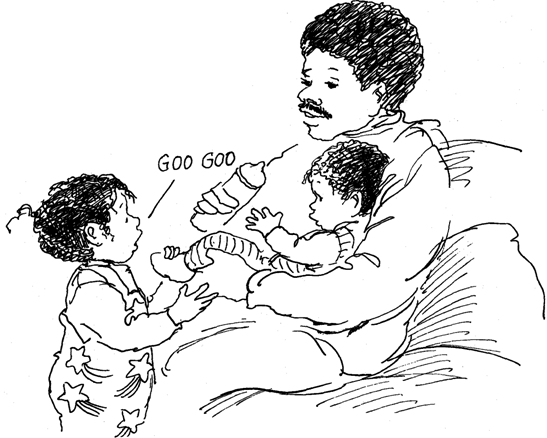
My New Favorite Word
Suddenly, "No" is your toddler's number one word of the month. It's not just your child who's being defiant. Most toddlers go through a stage of defiance, which is why moms, dads, and baby-sitters everywhere get frustrated with children this age. Children get frustrated, too. They really aren't out to get you. They're just developmentally at the stage where they need to spread their wings and try out a new kind of independence.
To cope, keep your sense of humor, offer reasonable alternatives, and realize that defiant moments pass, especially if you don't make too much of them.
Security Blankets
Security blankets are those worn-out blankets that children must have in order to go to bed. Security blankets do not have to be blankets. They can be certain pacifiers, certain cuddly toys, and certain bottles. Professionals call them "attachment objects." Some children call them necessary.
The problem with security blankets. 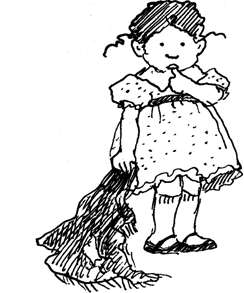
It's very simple. As comforting as they are - and they are - they are problems waiting to happen. The problem comes when the attachment object is not there. It was left behind at Grandma's house. Or it didn't get packed in order to go to Grandma's house and now Baby can't sleep. Or it needs to be washed, but Baby can't part with it - or rejects the cleaner version with horror.
Prevention is the best medicine.
If your child does not have a security blanket, don't introduce one. Children don't really need these things; they just think they do. Never suggest that a child must have a particular item in order to go to sleep or to take to day care. Children can learn to go to sleep peacefully without a security blanket. They can learn to go to day care without a certain toy.
The cure for security blankets.
Parents have come up with ingenious solutions. They have cut blankets down gradually until the child has nothing but a small square to hold. They have convinced toddlers to wrap up their security blankets and give them as a gifts to newborn children. They have offered more general substitutes - any toy instead of a particular rabbit named Fluffy. And they have been patient. College graduates do not carry security blankets. Sometimes all a parent can do is give in and wait.
Discipline
Picture it: Your toddler has been playing quietly in the next room while you have been talking on the phone. You have kept an ear out for your child and have heard your child playing very contentedly. So you haven't worried about your child's safety. However, when you go to check upon your child, you discover that your child has torn off all the leaves of your prize rubber tree plant. Rage sweeps through you, and what do you do? Shouting is too scary for toddlers, and spanking only makes things worse.
First, you control your rage. If you can't, you get someone else to watch your child. Second, you try to be objective and look again at the situation. Your child really did not mean to do anything wrong. Third, you react appropriately. The best way to handle this is to give a simple explanation of what was wrong and then to give your child a hug to show forgiveness.
Deliberate wrongdoing, on the other hand, gets a very firm and hugless "No." The key is, don't reward negative behavior deliberately.
Learning Right & Wrong
Many discipline problems can be prevented by showing children the proper way to treat objects and deal with situations. After your child has destroyed your plant and you have calmed down, teach your child how to help take care of your plants. Be clear. Say, "We don't pull green leaves off plants because that destroys the plant. Sometimes we pull off old brown leaves because they are dead and the plant doesn't need them anymore." Let your child help you take off some dead leaves.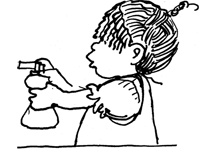
Children can perform useful tasks around the home. They like to do this. They like to be helpful. They don't really want to be "bad." It takes imagination on your part to think of little jobs children can do. You let your child do jobs, such as misting plants, with you, not because your child is really helping you. You could do the job better and faster. You let your child help you because your child needs to know how to do things right, as well as how to avoid doing things wrong.
And since misting plants is a positive behavior, you reward it with a display of your gratitude.
Toddlers & Teddy Bears
Babies are often given teddy bears as presents after they are born. But actually, little babies don't care much for teddy bears so the teddy bears are ignored for a while. Now is the time to get them down from the shelf because at this age your toddler is old enough and mature enough to develop an emotional attachment to a teddy bear.
Be sure the bear is safe and well made. The eyes and nose should be embroidered on or very securely attached. There should be no buttons to chew off and swallow. Avoid wind-up, musical teddy bears. They're not as cuddly, and any small mechanism could come out and get swallowed.
Teddy Bear Activities
Teddy bears are good for more than cuddling. You can dance with them, sing to them, and even toss them around a little. Small teddy bears are perfect, pre-ball objects to play with. Toss them like beanbags into big boxes or baskets. Don't make this activity harder than it should be. Toddlers can stand as close as they want to the basket. There's no competition; everyone wins at the teddy bear game! If you're smart, you can develop this activity into a cleanup game.
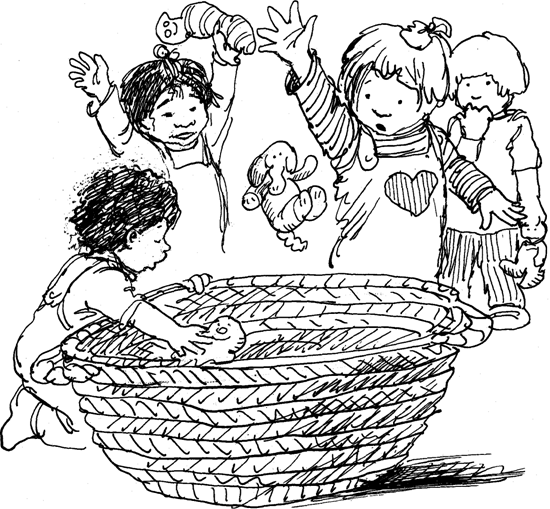
CLICK FOR CHAPTER TWO
|

